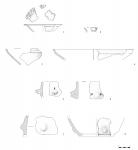Summary (English)
This was the first season of excavations on the site of Grotta del Leone, Agnano (PI). Five trenches were opened, situated in various areas of the cavern (Fig. 1).
Trenches 1-2 and 3 produced positive results as they intercepted archaeological deposits: Trench 1-2 revealed a hearth structure attributable to the recent Neolithic period; in Trench 3 a level attributable to the Upper Palaeolithic was partially investigated.- Trench 1-2 (2 × 6 m)
Part of a hearth structure was uncovered below a stalagmitic concretion c. 20 cm thick, present in quadrants F9, F8, G9 and G8. It was characterised by a dark brown-grey clay-silt layer (US 1) with abundant and scattered charcoal fragments, and carbonised grain. The hearth was built with quartzite slabs, some still intact others fragmented by the heat, partially immerged in the charcoally layer and partially incorporated into the overlying stalagmitic concretion sealing the context.
Numerous bone fragments with clear traces of burning and pottery fragments attributable to the recent Neolithic Chassey culture were found in the hearth (Fig. 2).- Trench 3 (2 × 3 m)
The northern edge of Radmilli’s excavation was intercepted in quadrants C15 and D15 below a layer of heavily disturbed and un-homogeneous soil (US 1). In the remaining quadrants a reddish-brown clay-silt layer (US 2) was uncovered in which the following pits were present: Buca 1, Buca 2, Buca 3, Buca 4, Buca 5, Buca 6 e Buca 7 UUSS 3-9. These pits were recorded and excavated. The fill (US 8) in Buca 6 was of interest as it contained numerous grains, all of which were collected. Following the excavation of the pits, the surrounding layers US 2 and US 10 were investigated, which produced lithic industry attributable to the Upper Palaeolithic period.To date, trenches 4 and 5 have not produced positive results and are characterised by the presence of large limestone blocks interpreted as collapse. In trench 5, expanding mortar was used to dismantle these large blocks in order to reveal the underlying deposit and check the conservation of the anthropic stratigraphy.
- Lucia Angeli - Dipartimento di Civiltà e Forme del Sapere, Università di Pisa
Director
- Giovanna Radi - Dipartimento di Civiltà e Forme del Sapere, Università di Pisa
Team
- Gianbattista Marras- Dipartimento di Civiltà e Forme del Sapere, Università di Pisa
- Jcopo Conforti- Dipartimento di Civiltà e Forme del Sapere, Università di Pisa
- Marcella Parisi- Dipartimento di Civiltà e Forme del Sapere, Università di Pisa
- Raffaella Milano - Dipartimento di Civiltà e Forme del Sapere, Università di Pisa
- Stefania Rao - Dipartimento di Civiltà e Forme del Sapere, Università di Pisa
Research Body
- Dipartimento di Civiltà e Forme del Sapere, Università di Pisa






![Download [PDF]](/excavation/skins/fasti/images/results/download_sml.png)
